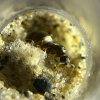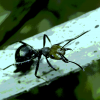- Formiculture.com
- Forums
- Gallery
- Members
- Member Map
- Chat

Best spots to find Formica.
Started By
michiganantsinmyyard
, Jul 14 2024 7:56 AM
8 replies to this topic
#1
 Offline
-
Posted July 14 2024 - 7:56 AM
Offline
-
Posted July 14 2024 - 7:56 AM
Title is self explanatory. It’s Formica season and I’d really like to keep them. Don’t have any around my house unfortunately. What sort of spots do Formica like? Would it be better if I went to a drier prairie area, or a thick forest?
#2
 Offline
-
Posted July 14 2024 - 11:16 AM
Offline
-
Posted July 14 2024 - 11:16 AM
Depends on the species. Are you looking for social parasites or semi-claustral queens? If you want Fusca group, I made a video looking in the woods a few years back found here. But you'll also be able to find some species in the drier prairie. Either way look during warm days for queens, especially after rain. Flipping rocks is another viable option for some species.
Leave the Road, take the Trails - Pythagoras
Utah Ant Keeping --- Here
DIY Formicariums and Outworlds --- Here
Honeypot Ant Journal --- Here
Photo Album --- Here
Videos --- Here
#3
 Offline
-
Posted July 14 2024 - 6:30 PM
Offline
-
Posted July 14 2024 - 6:30 PM
Michigan has fantastic Formica diversity and in my opinion, this genus makes up some of the coolest ants in that state. Here are some notes from where I've found them in Ontario:
Fusca-group: You can find these in sidewalks in urban and suburban areas. They can also be found under logs in forested areas, usually in spots where there is lots of sunlight. They can also build mounds - I've found that their mounds are usually mainly soil, although sometimes have plant matter on top, but never in a dense layer. I've noticed their mounds will have entrances all over the surface. I've seen them in grasslands, urban environments, and even on the sides of forested trails.
Integra-group: I've only seen F. integra here. I found one colony in a large fallen log in a grassland area that had some brush coming in (maybe 1-2m high?). They had built a nest out of plant matter on top of the log. I'd found some similarly in a plant matter nest in an old stump off the side of a road. Up north (on the shield), I've found them in plant matter nests in the cracks of granite outcroppings on the sides of the road. I've also found them in clumps of grass beside a pond. In all cases they were in sunny areas. These also form large foraging trails that are clearly visible when they cross hiking paths. You can try follow these back to the nest.
Pallidefulva-group: These are most common in areas with sandy soil I find. They build nests on trails directly in the ground, and have pretty distinct nest entrances - they look like your standard ant hill with 2 or 3 fairly large holes. Picture a Lasius nest entrance but scaled up significantly.
Exsecta-group: F. exsectoides and F. ulkei build very nice thatched mounds. Here, I find the mounds are composed mainly of soil but will have a crust or layer of plant matter ontop - pine needles, cut grass, etc. I notice they will trim vegetation around the mound too. These are some of the most impressive ant nests I've seen. You can find these mounds on the sides of country roads, and in grassy open areas. I've noticed they are also associated with forest margins. These nests are often in tall grass, so I find they're easiest to map in the early spring or late winter before the grass has all grown up.
Sanguinea-group: I've found these nesting in similar sites to integra-group, with the addition that I've seen them build dirt mounds similar to fusca-group.
Some final notes: this is obviously not an exhaustive list, and I don't recommend you constrain your search solely to the areas I list. But I hope this can guide your search. At the end of the day, Formica are thermophilic ants, so if the area is not sunny/does not receive much sunlight, I would recommend against looking there. Hence I usually don't visit forests (saves me the trouble of dealing with mosquitos too). Also, geology is everything. In some geologies, fusca-group seem dominant and the main parasite is exsecta-group - but you drive just an hour away and the main Formica is pallidefulva-group, and integra-group are the main parasite.
One last tip: I recommend checking Your Home · iNaturalist and searching for Formica in your state. This will give you an idea of which species are present and where, and can help guide you to the locations where they can be found. Hope that helps!
- michiganantsinmyyard likes this
#4
 Offline
-
Posted July 15 2024 - 1:20 PM
Offline
-
Posted July 15 2024 - 1:20 PM
look where grass grows in sandy soil and you'll probably find F perpilosa which is super easy to rear
#5
 Offline
-
Posted July 17 2024 - 5:37 AM
Offline
-
Posted July 17 2024 - 5:37 AM
Michigan has fantastic Formica diversity and in my opinion, this genus makes up some of the coolest ants in that state. Here are some notes from where I've found them in Ontario:
Fusca-group: You can find these in sidewalks in urban and suburban areas. They can also be found under logs in forested areas, usually in spots where there is lots of sunlight. They can also build mounds - I've found that their mounds are usually mainly soil, although sometimes have plant matter on top, but never in a dense layer. I've noticed their mounds will have entrances all over the surface. I've seen them in grasslands, urban environments, and even on the sides of forested trails.
Integra-group: I've only seen F. integra here. I found one colony in a large fallen log in a grassland area that had some brush coming in (maybe 1-2m high?). They had built a nest out of plant matter on top of the log. I'd found some similarly in a plant matter nest in an old stump off the side of a road. Up north (on the shield), I've found them in plant matter nests in the cracks of granite outcroppings on the sides of the road. I've also found them in clumps of grass beside a pond. In all cases they were in sunny areas. These also form large foraging trails that are clearly visible when they cross hiking paths. You can try follow these back to the nest.
Pallidefulva-group: These are most common in areas with sandy soil I find. They build nests on trails directly in the ground, and have pretty distinct nest entrances - they look like your standard ant hill with 2 or 3 fairly large holes. Picture a Lasius nest entrance but scaled up significantly.
Exsecta-group: F. exsectoides and F. ulkei build very nice thatched mounds. Here, I find the mounds are composed mainly of soil but will have a crust or layer of plant matter ontop - pine needles, cut grass, etc. I notice they will trim vegetation around the mound too. These are some of the most impressive ant nests I've seen. You can find these mounds on the sides of country roads, and in grassy open areas. I've noticed they are also associated with forest margins. These nests are often in tall grass, so I find they're easiest to map in the early spring or late winter before the grass has all grown up.
Sanguinea-group: I've found these nesting in similar sites to integra-group, with the addition that I've seen them build dirt mounds similar to fusca-group.
Some final notes: this is obviously not an exhaustive list, and I don't recommend you constrain your search solely to the areas I list. But I hope this can guide your search. At the end of the day, Formica are thermophilic ants, so if the area is not sunny/does not receive much sunlight, I would recommend against looking there. Hence I usually don't visit forests (saves me the trouble of dealing with mosquitos too). Also, geology is everything. In some geologies, fusca-group seem dominant and the main parasite is exsecta-group - but you drive just an hour away and the main Formica is pallidefulva-group, and integra-group are the main parasite.
One last tip: I recommend checking Your Home · iNaturalist and searching for Formica in your state. This will give you an idea of which species are present and where, and can help guide you to the locations where they can be found. Hope that helps!
This is extremely helpful, thanks! I looked around a park in areas you described, and I found a massive Sanguinea-group in the middle of a slave raid. I just hope I didn't miss any Formica flights, but I will be sure to look in that area.
- Nare likes this
#6
 Offline
-
Posted July 17 2024 - 5:38 AM
Offline
-
Posted July 17 2024 - 5:38 AM
look where grass grows in sandy soil and you'll probably find F perpilosa which is super easy to rear
As far as I know F. perpilosa doesn't exist in Michigan.
#7
 Offline
-
Posted July 17 2024 - 8:37 PM
Offline
-
Posted July 17 2024 - 8:37 PM
New to the hobby, so take what I say with a grain of salt.
I'm over in a suburb of Minneapolis, Minnesota. I've caught seven Formica queens (species still uncertain, possibly neogagates, lasioides, vinculans, incerta, pallidefulva) this summer. They're fast moving and difficult to catch. They never seem to stand still like Camponotus and Tetramorium queens will. Nearly every single one I've seen is scurrying around on my asphalt driveway or concrete. It's possible I just happen to have a well established population in my area. I'll also note that the first one I caught was in late June and caught another three yesterday in relatively cool weather (temp was mid-70s F, didn't feel muggy, but not very dry either). Last year I only found one. We had drought conditions while this year we've had more then average rainfall.
Good luck on your quest
- Stubyvast likes this
Test Tube queens (new in 2024):
7x F. Pallidefulva with eggs & larva
5x T. Immigrans with eggs
1x C. Pennyslvanicus with pupa & 1 worker
Formicarium w/ outworld (founded 2023):
1x C. Pennyslvanicus queen with 9 minors
#8
 Offline
-
Posted July 18 2024 - 3:03 PM
Offline
-
Posted July 18 2024 - 3:03 PM
look where grass grows in sandy soil and you'll probably find F perpilosa which is super easy to rear
As far as I know F. perpilosa doesn't exist in Michigan.
you'll probably find some other formica that fits this niche at the very least. alot of them like sandy grassy areas
#9
 Offline
-
Posted July 19 2024 - 2:28 PM
Offline
-
Posted July 19 2024 - 2:28 PM
New to the hobby, so take what I say with a grain of salt.
I'm over in a suburb of Minneapolis, Minnesota. I've caught seven Formica queens (species still uncertain, possibly neogagates, lasioides, vinculans, incerta, pallidefulva) this summer. They're fast moving and difficult to catch. They never seem to stand still like Camponotus and Tetramorium queens will. Nearly every single one I've seen is scurrying around on my asphalt driveway or concrete. It's possible I just happen to have a well established population in my area. I'll also note that the first one I caught was in late June and caught another three yesterday in relatively cool weather (temp was mid-70s F, didn't feel muggy, but not very dry either). Last year I only found one. We had drought conditions while this year we've had more then average rainfall.
Good luck on your quest
Interesting! I've been waiting for a colony of formica pacifica to fly outside my house for a while now. And like you said, rainy conditions seem to help. Maybe I'm more likely to find them this year then! Very good to know.
Manica invidia (1 queen, ~200 workers)
Manica invidia (1 colonies, 1 queens plus 3 workers)
Lasius niger (single queen, ~200 workers - naturalistic, predatory set-up)
Lasius americanus (1 colony, ~10 workers)
Tetramorium immigrans (3 colonies, 3 queens, ~ five workers each | 1 colony, 1 queen, ~1200 workers)
Formica aserva (aserva queen, ~15 Formica neorufibarbis workers)
"And God made...everything that creeps on the ground according to its kind.
And God saw that it was good." - Genesis 1:25
0 user(s) are reading this topic
0 members, 0 guests, 0 anonymous users















